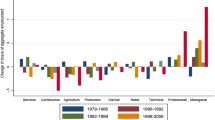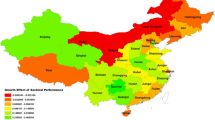Abstract
The purpose of this paper is to explore employment differences over time across China’s hi-tech zones. Using data from China’s Ministry of Science and Technology, we find that if a university science park is within a hi-tech zone, employment in that zone is higher, but that finding only holds for zones established in the pre-information communication technology period. After 2000, proximity to a university science park does not appear to be necessary for the exchange of tacit knowledge which we contend leverages the technology base of firms and organizations in the zone and thus their level of employment. We also find greater employment in hi-tech zones in which information technology is a dominant industry.

Similar content being viewed by others
Notes
One example was China’s development of a clean-technology industry (Campbell 2013). Due to concerns of dependence on foreign oil and heavy environmental pollution in China, the Chinese government has been investing in energy technology projects, especially renewable energy and energy storage technology. China is now a leading country in solar cell industry.
In China, science parks are linked with one or more universities, and they are usually located in or close to a university. The hi-tech zones discussed in this paper are different from university science parks. Hi-tech zones are larger than university science parks and might include one or more university parks in the zone.
An earlier version of this paper was presented at the Technology Transfer Society annual conference at George Mason University. We thank Cristiano Antonelli and Nick Vonortas for their helpful comments and suggestions.
Any park founded in 2015 is thus coded as having an age of 1 year.
Link and Yang (2017) investigated a distance variable in their analysis of the employment growth among Korean technoparks, but they found no statistical relationship between distance and employment using a model similar to that in equation (1) above.
Hobbs et al. (2017b, p. 503) wrote: “… the ICT revolution mitigated aspects of the need for scientists to have face-to-face interactions with university scientists and [it] increased park productivity more generally …”
These results are available from the authors on request.
References
Campbell, J. R. (2013). “Becoming a Techno-Industrial Power: Chinese Science and Technology Policy,” https://www.brookings.edu/research/becoming-a-techno-industrial-power-chinese-science-and-technology-policy/.
China Statistical Yearbook (2016). http://www.stats.gov.cn/tjsj/ndsj/2016/indexeh.htm.
Hobbs, K. G., Link, A. N., & Scott, J. T. (2017a). Science and technology parks: an annotated and analytical literature review. Journal of Technology Transfer, 42, 957–976. https://doi.org/10.1007/s10961-016-9522-3.
Hobbs, K. G., Link, A. N., & Scott, J. T. (2017b). The growth of US science and technology parks: does proximity to a university matter? Annals of Regional Science, 59, 495–511. https://doi.org/10.1007/s00168-017-0842-5.
Hu, A. G. (2007). Technology parks and regional economic growth in China. Research Policy, 36, 76–87. https://doi.org/10.1016/j.respol.2006.08.003.
Link, A. N., & Link, K. R. (2003). On the growth of U.S. Science Parks. Journal of Technology Transfer, 28, 81–85. https://doi.org/10.1023/A:1021634904546.
Link, A. N., & Scott, J. T. (2003). U.S. science parks: the diffusion of an innovation and its effects on the academic mission of universities. International Journal of Industrial Organization, 21, 1323–1356. https://doi.org/10.1016/S0167-7187(03)00085-7.
Link, A. N., & Scott, J. T. (2006). U.S. university research parks. Journal of Productivity Analysis, 25, 43–55. https://doi.org/10.1007/s11123-006-7126-x.
Link, A. N., & Scott, J. T. (2007). The economics of university research parks. Oxford Review of Economic Policy, 23, 661–674. https://doi.org/10.1093/oxrep/grm030.
Link, A. N., & Scott, J. T. (2015). Research, science, and technology parks: Vehicles for technology transfer. In A. N. Link, D. S. Siegel, & M. Wright (Eds.), The Chicago handbook of university technology transfer and academic entrepreneurship. Chicago: University of Chicago Press. https://doi.org/10.7208/chicago/9780226178486.003.0006.
Link, A. N., & Yang, U. Y. (2017). On the growth of Korean technoparks. International Entrepreneurship and Management Journal. https://doi.org/10.1007/s11365-017-0459-2.
Ministry of Science and Technology (MOST) (2011, 2017). “National High-Tech Industrial Zones in China,” http://www.chinatorch.gov.cn.
Su, D.-J., Wu, B., Sohn, D.-W., & Zhou, D.-Y. (2016). The trajectory of university science parks (USPs) in China: institutional evolution and assessment. STI Policy Review, 7, 16–34.
Author information
Authors and Affiliations
Corresponding author
Rights and permissions
About this article
Cite this article
Chen, C., Link, A.N. Employment in China’s hi-tech zones. Int Entrep Manag J 14, 697–703 (2018). https://doi.org/10.1007/s11365-017-0486-z
Published:
Issue Date:
DOI: https://doi.org/10.1007/s11365-017-0486-z




